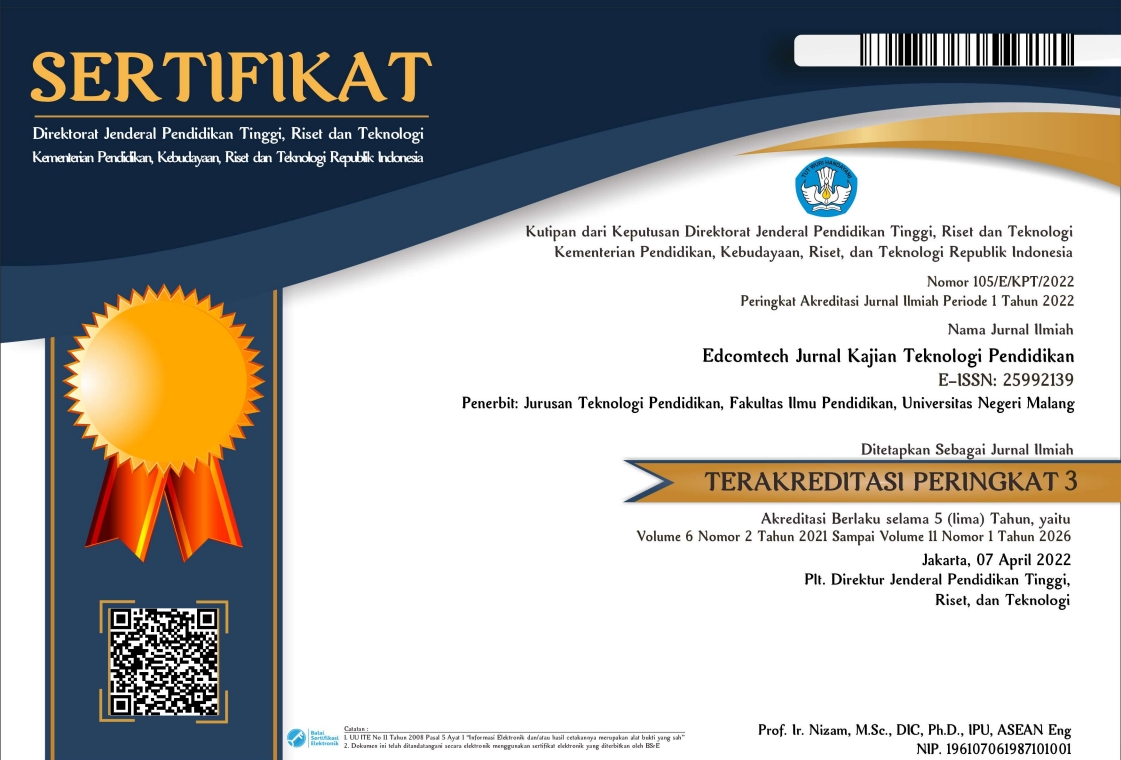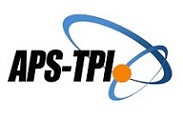Pembelajaran Blending Asynchronous-Synchronous Learning Berbasis Relevan terhadap Hasil Belajar Koqnitif Peserta Didik Sekolah Dasar pada Masa Pandemi
Abstract
Abstrak: Penelitian strategi pembelajaran berbasis relevan dengan metode blending asynchronous dan synchronous terhadap hasil belajar kognitif peserta didik kelas 5 Sekolah Dasar bertujuan untuk mengetahui dampak pembelajaran online terhadap kognitif peserta didik. Dalam riset ini kelas kontrol dan kelas eksperimen mendapat media pembelajaran yang sama, asynchronous learning menggunakan aplikasi Google Classrom sehingga peserta didik dapat mengirim materi, dapat mengumpulkan tugas dan dapat berkomunikasi secara tidak langsung dengan guru. Sedangkan synchronous learning menggunakan aplikasi zoom, dimana peserta didik dapat berinteraksi dan berkomuniasi dengan guru dan teman secara langsung. Kelas control tidak menggunakan pembelajaran berbasis relevan berjumlah 24 anak dan kelas eksperimen, menggunakan pembelajaran berbasis relevan berjumlah 44 anak. Hasil penelitian diperoleh rata- rata pretest kelas control sebesar 54,38 serta kelas eksperimen 55,94 sebaliknya hasil rata- rata posttest kelas control sebesar 63,54 serta kelas eksperimen sebesar 83,50. Hasil ini menampilkan perbedaan yang signifikan, setelah itu dilanjutkan dengan uji statistic sampai pada tahap uji korelasi dan memperoleh hasil yang signifikan sebesar 0.743 serta sig 0.000. Kontribusi pembelajaran berbasis relevan sebesar 55.1% terhadap hasil belajar kognitif siswa.
Abstract: Research on blending relevance based asynchronous and synchronous learning across the cognitive result of 5th grade elementary school students. The aim is to determine the impact of online learning on cognitive students. In this research, the control class and the experimental class received the same learning media, asynchronous learning using the Google Classroom application so that students could send materials, collect assignments and communicate indirectly with the teacher. Meanwhile, synchronous learning uses a zoom application, where students can interact and communicate with teachers and friends directly. The control class did not use relevant-based learning with a total of 24 children and the experimental class, which used relevant-based learning, amounted to 44 children. The results showed that the average pretest for the control class was 54.38 and the experimental class was 55.94. On the other hand, the average posttest for the control class was 63.54 and the experimental class was 83.50. These results show a significant difference, then continued with statistical tests to the correlation test stage and obtained significant results of 0.743 and 0.000 sig. The contribution of relevant-based learning is 55.1% to students' cognitive learning outcomes.
Keywords
Full Text:
PDFReferences
Abrams, L., Varier, D., & Jackson, L. (2016). Unpacking instructional alignment: The influence of teachers’ use of assessment data on instruction. Perspectives in Education, 34(4). https://doi.org/10.18820/2519593X/pie.v34i4.2
Albrecht, J. R., & Karabenick, S. A. (2018). Relevance for Learning and Motivation in Education. Journal of Experimental Education. https://doi.org/10.1080/00220973.2017.1380593
Alexander, P. A. (2018). The Relevance of Relevance for Learning and Performance. Journal of Experimental Education. https://doi.org/10.1080/00220973.2017.1380592
Allott, N. (2013). Relevance theory. In Perspectives in Pragmatics, Philosophy and Psychology (Vol. 2). https://doi.org/10.1007/978-3-319-01014-4_3
Amiti, F. (2020). Synchronous and asynchronous e-learning. European Journal of Open Education and E-Learning Studies, 5(2).
Azhari, B., & Fajri, I. (2021). Distance learning during the COVID-19 pandemic: School closure in Indonesia. International Journal of Mathematical Education in Science and Technology. https://doi.org/10.1080/0020739X.2021.1875072
Baird, J. A., Andrich, D., Hopfenbeck, T. N., & Stobart, G. (2017). Assessment and learning: fields apart? Assessment in Education: Principles, Policy and Practice, 24(3). https://doi.org/10.1080/0969594X.2017.1319337
Bohn-Gettler, C. M., & McCrudden, M. T. (2018). Effects of Task Relevance Instructions and Topic Beliefs on Reading Processes and Memory. Discourse Processes, 55(4). https://doi.org/10.1080/0163853X.2017.1292824
Brown, G. T. L. (2019). Is Assessment for Learning Really Assessment? Frontiers in Education, 4. https://doi.org/10.3389/feduc.2019.00064
Chen, P. P., & Bonner, S. M. (2020). A framework for classroom assessment, learning, and self-regulation. Assessment in Education: Principles, Policy and Practice, 27(4). https://doi.org/10.1080/0969594X.2019.1619515
Choe, R. C., Scuric, Z., Eshkol, E., Cruser, S., Arndt, A., Cox, R., … Crosbie, R. H. (2019). Student satisfaction and learning outcomes in asynchronous online lecture videos. CBE Life Sciences Education, 18(4), 1–14. https://doi.org/10.1187/cbe.18-08-0171
Dann, R. (2014). Assessment as learning: Blurring the boundaries of assessment and learning for theory, policy and practice. Assessment in Education: Principles, Policy and Practice, 21(2). https://doi.org/10.1080/0969594X.2014.898128
Doo, M. Y., & Bonk, C. J. (2021). Cognitive Instrumental Processes of Flipped Learners: Effects of Relevance for Learning, Quality of Learning Outcomes, and Result Demonstrability. Journal of Educational Computing Research, 59(6). https://doi.org/10.1177/0735633121989128
G. Dada, E., H. Alkali, A., & O. Oyewola, D. (2019). An Investigation into the Effectiveness of Asynchronous and Synchronous E-learning Mode on Students’ Academic Performance in National Open University (NOUN), Maiduguri Centre. International Journal of Modern Education and Computer Science, 11(5), 54–64. https://doi.org/10.5815/ijmecs.2019.05.06
Geraniou, E., & Crisan, C. (2019). University students’ engagement with an asynchronous online course on digital technologies for mathematical learning. Eleventh Congress of the European Society for Research in Mathematics Education, 1–8. Retrieved from https://discovery.ucl.ac.uk/id/eprint/10077723
Jeon, E. Y. (2020). What makes them the best English teachers? An analysis of the motivational strategy use based on ARCS model. Educational Research for Policy and Practice, 20(3), 263–278. https://doi.org/10.1007/s10671-020-09279-1
Krause, S. J., Waters, C., Stuart, W. J., Judson, E., Ankeny, C. J., & Smith, B. B. (2016). Effect of contextualization of content and concepts on students’ course relevance and value in introductory materials classes. In ASEE Annual Conference and Exposition, Conference Proceedings (pp. 1–17).
Kurt, P. Y., & Kecik, I. (2017). The Effects of ARCS Motivational Model on Student Motivation to Learn English. European Journal of Foreign Languange Teaching. https://doi.org/10.5281/zenodo.254605
Mailizar, Almanthari, A., Maulina, S., & Bruce, S. (2020). Secondary school mathematics teachers’ views on e-learning implementation barriers during the COVID-19 pandemic: The case of Indonesia. Eurasia Journal of Mathematics, Science and Technology Education, 16(7). https://doi.org/10.29333/EJMSTE/8240
Malik, M., Fatima, G., Hussain Ch., A., & Sarwar, A. (2017). E-learning: Students’ perspectives about asynchronous and synchronous resources at higher education level. Bulletin of Education and Research, 39(2), 183–195.
McCrudden, M. T. (2019). The effect of task relevance instructions on memory for text with seductive details. Applied Cognitive Psychology, 33(1). https://doi.org/10.1002/acp.3455
Nasution, M. R. (2020). Covid-19 Tidak Menjadi Hambatan Pendidikan Di Indonesia. Jurnal Pendidikan, (April).
Ogbonna, C. G., Ibezim, N. E., & Obi, C. A. (2019). Synchronous versus asynchronous e-learning in teaching word processing: An experimental approach. South African Journal of Education, 39(2). https://doi.org/10.15700/saje.v39n2a1383
Palvia, S. C. (2000). Effectiveness of asynchronous and synchronous modes for learning computer software for end users: An experimental investigation. Journal of Computer Information Systems, 41(2), 99–109. https://doi.org/10.1080/08874417.2002.11646998
Reynolds, K. M., Roberts, L. M., & Hauck, J. (2017). Exploring motivation: integrating the ARCS model with instruction. Reference Services Review, 45(2). https://doi.org/10.1108/RSR-10-2016-0057
Riwayatiningsih, R., & Sulistyani, S. (2020). THE IMPLEMENTATION OF SYNCHRONOUS AND ASYNCHRONOUS E- LANGUAGE LEARNING IN EFL SETTING: A CASE STUDY. JURNAL BASIS, 7(2), 309. https://doi.org/10.33884/basisupb.v7i2.2484
Ross, S. M., Morrison, G. R., & Lowther, D. L. (2020). Educational Technology Research Past and Present: Balancing Rigor and Relevance to Impact School Learning. Contemporary Educational Technology, 1(1). https://doi.org/10.30935/cedtech/5959
Schmidt, J. A., Kafkas, S. S., Maier, K. S., Shumow, L., & Kackar-Cam, H. Z. (2019). Why are we learning this? Using mixed methods to understand teachers’ relevance statements and how they shape middle school students’ perceptions of science utility. Contemporary Educational Psychology, 57, 9–31. https://doi.org/10.1016/j.cedpsych.2018.08.005
Shahabadi, M. M., & Uplane, M. (2015). Synchronous and Asynchronous e-learning Styles and Academic Performance of e-learners. Procedia - Social and Behavioral Sciences, 176, 129–138. https://doi.org/10.1016/j.sbspro.2015.01.453
Shorten, C., Khoshgoftaar, T. M., & Furht, B. (2021). Deep Learning applications for COVID-19. Journal of Big Data, 8(1). https://doi.org/10.1186/s40537-020-00392-9
Susanti, L., & Imbiri, C. (2020). Implementasi Motivasi Model ARCS (Attention, Relevance, Confidence, and Satisfaction) dalam Pembelajaran Pendidikan Agama Kristen. DUNAMIS: Jurnal Teologi Dan Pendidikan Kristiani, 4(2), 254–263. https://doi.org/10.30648/dun.v4i2.284
Syah, R. H. (2020). Dampak Covid-19 pada Pendidikan di Indonesia: Sekolah, Keterampilan, dan Proses Pembelajaran. SALAM: Jurnal Sosial Dan Budaya Syar-I, 7(5). https://doi.org/10.15408/sjsbs.v7i5.15314
Yamagata-Lynch, L. C. (2014). Blending online asynchronous and synchronous learning. International Review of Research in Open and Distance Learning, 15(2), 189–212. https://doi.org/10.19173/irrodl.v15i2.1778
Zeng, Y., & Liu, Y. (2021). Relevance Strategy in Reading and Reading Instruction. Humanities and Social Sciences, 9(2), 32–44. https://doi.org/10.11648/j.hss.20210902.11
DOI: http://dx.doi.org/10.17977/um039v7i12022p079
Refbacks
- There are currently no refbacks.
Copyright (c) 2022 Lidia Susanti, Rira Estherina

This work is licensed under a Creative Commons Attribution-ShareAlike 4.0 International License.
Edcomtech: Jurnal Kajian Teknologi Pendidikan published by Department of Educational Technology, Faculty of Education, State University of Malang in Collaboration with Asosiasi Program Studi Teknologi Pendidikan Indonesia (APS TPI) and Ikatan Profesi Teknologi Pendidikan Indonesia (IPTPI) with MoU.
Publisher Address:
Lab. Teknologi Pendidikan, Gd.E2, Lt.1
Fakultas Ilmu Pendidikan Universitas Negeri Malang
Jalan Semarang No 5, Kota Malang Kode Pos 65145
Email: edcomtech.fip@um.ac.id
========================================================================================================
| INDEXED BY | TOOLS | PLAGIARISM CHECK | ARTICLE TEMPLATE |
|

Edcomtech is licensed under a Creative Commons Attribution-ShareAlike 4.0 International License.
Edcomtech Statistics (Since July 13th, 2020)











1.png)








